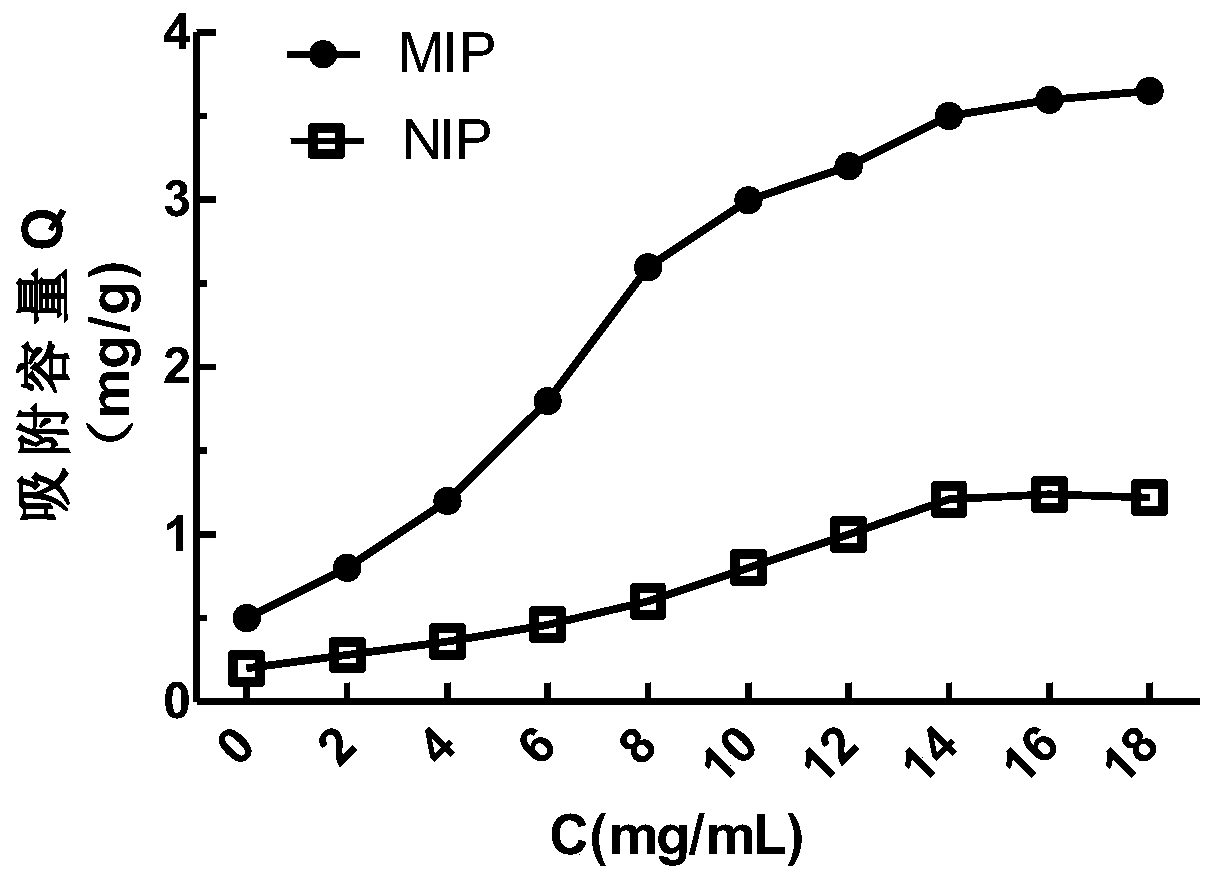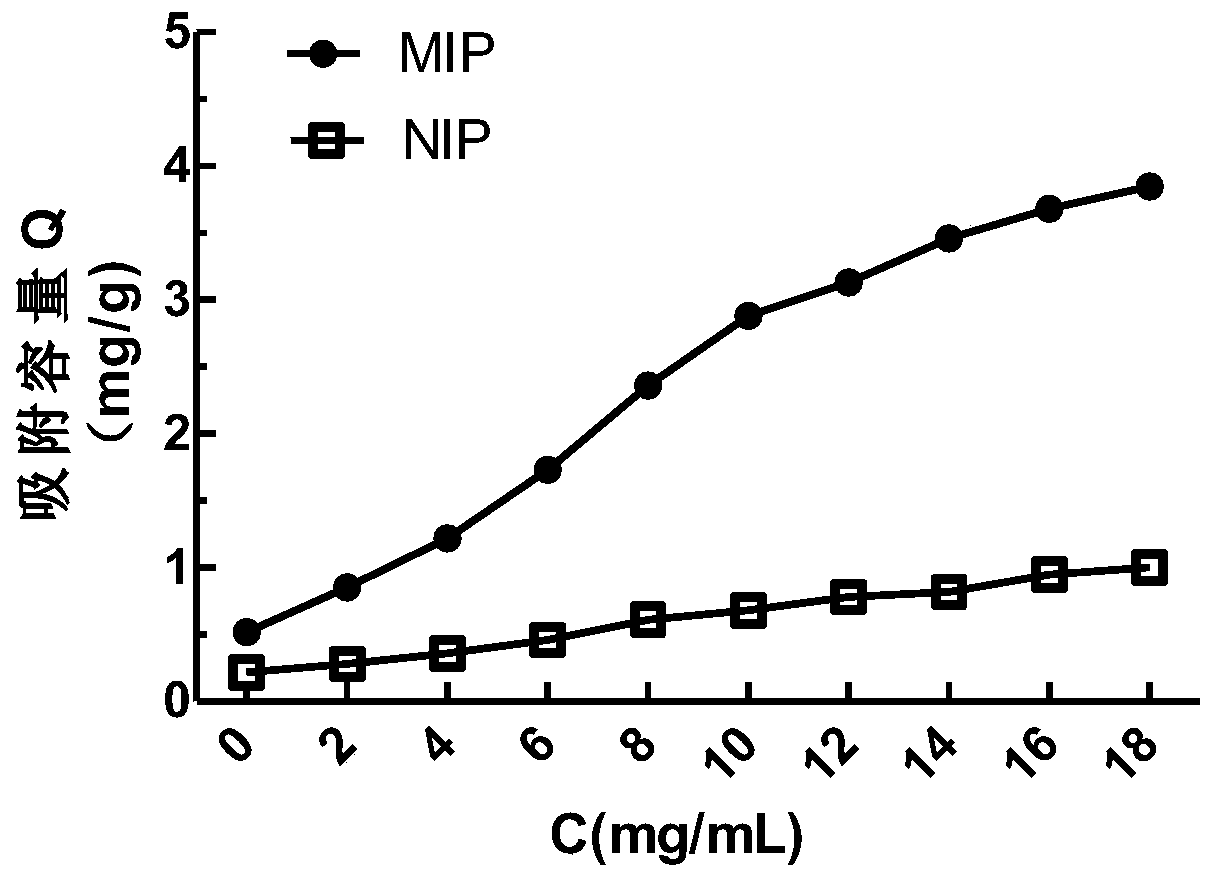Molecularly imprinted polymer for adsorption of vitamin C and preparation method thereof
A technology of molecular imprinting and vitamins, which is applied in the fields of alkali metal compounds, chemical instruments and methods, and other chemical processes, can solve the problems of long analysis time and complicated processing process, and achieve the goal of simplifying the preparation process, simple process, and improving utilization rate Effect
- Summary
- Abstract
- Description
- Claims
- Application Information
AI Technical Summary
Problems solved by technology
Method used
Image
Examples
Embodiment 1
[0028] Preparation of Molecularly Imprinted Polymers for Adsorbing Vitamin C
[0029] (1) FeCl 2 and FeCl 3 Dissolve in deionized water, raise the temperature to 80°C, add ammonia water dropwise, react for 20 minutes, filter to get the filter residue, wash the filter residue with deionized water and dry at 50°C for 8 hours to obtain Fe 3 o 4 Particles, where FeCl 2 , FeCl 3 The mass volume ratio with ammonia water is 1:3:6, and the unit of mass volume ratio is g:g:mL;
[0030] (2) Fe obtained in step (1) 3 o 4 Add the particles into ethanol aqueous solution (the volume ratio of ethanol to deionized water is 1:1), ultrasonicate for 20 minutes, then add ammonia water and tetraethyl orthosilicate in turn, react at room temperature for 24 hours and filter to obtain silica magnetic nanoparticles ; Among them, Fe 3 o 4 The mass volume ratio of particles, ethanol aqueous solution, ammonia water and tetraethyl orthosilicate is 1:40:5:3, and the unit of mass volume ratio is g:...
Embodiment 2
[0033] Preparation of Molecularly Imprinted Polymers for Adsorbing Vitamin C
[0034] (1) FeCl 2 and FeCl 3 Dissolve in deionized water, raise the temperature to 70°C, add ammonia water dropwise, react for 25 minutes, filter to get the filter residue, wash the filter residue with deionized water and dry at 60°C for 10 hours to obtain Fe 3 o 4 Particles, where FeCl 2 , FeCl 3 The mass volume ratio to ammonia water is 1:2.7:5.8, and the unit of mass volume ratio is g:g:mL;
[0035] (2) Fe obtained in step (1) 3 o 4 Add the particles into ethanol aqueous solution (the volume ratio of ethanol to deionized water is 1:1), ultrasonicate for 20 minutes, then add ammonia water and tetraethyl orthosilicate in turn, react at room temperature for 20 hours and filter to obtain silica magnetic nanoparticles ; Among them, Fe 3 o 4 The mass volume ratio of particles, ethanol aqueous solution, ammonia water and tetraethyl orthosilicate is 1:35:4:2.5, and the unit of mass volume ratio ...
Embodiment 3
[0038] Preparation of Molecularly Imprinted Polymers for Adsorbing Vitamin C
[0039] (1) FeCl 2 and FeCl 3 Dissolve in deionized water, raise the temperature to 75°C and add ammonia water dropwise, react for 30 minutes and filter to get the filter residue, wash the filter residue with deionized water and dry at 70°C for 9 hours to obtain Fe 3 o 4 Particles, where FeCl 2 , FeCl 3 The mass volume ratio with ammonia water is 1:2.8:5.9, and the unit of mass volume ratio is g:g:mL;
[0040] (2) Fe obtained in step (1) 3 o 4 Add the particles into ethanol aqueous solution (the volume ratio of ethanol to deionized water is 1:1), ultrasonicate for 20 minutes, then add ammonia water and tetraethyl orthosilicate in turn, react at room temperature for 22 hours and filter to obtain silica magnetic nanoparticles ; Among them, Fe 3 o 4 The mass volume ratio of particles, ethanol aqueous solution, ammonia water and tetraethyl orthosilicate is 1:37:4.5:3, and the unit of mass volume...
PUM
 Login to view more
Login to view more Abstract
Description
Claims
Application Information
 Login to view more
Login to view more - R&D Engineer
- R&D Manager
- IP Professional
- Industry Leading Data Capabilities
- Powerful AI technology
- Patent DNA Extraction
Browse by: Latest US Patents, China's latest patents, Technical Efficacy Thesaurus, Application Domain, Technology Topic.
© 2024 PatSnap. All rights reserved.Legal|Privacy policy|Modern Slavery Act Transparency Statement|Sitemap



